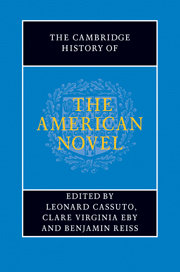Book contents
- Frontmatter
- General Introduction
- PART ONE INVENTING THE AMERICAN NOVEL
- PART TWO REALISM, PROTEST, ACCOMMODATION
- PART THREE MODERNISM AND BEYOND
- PART FOUR CONTEMPORARY FORMATIONS
- Introduction: contemporary formations
- 58 Postmodern novels
- 59 The nonfiction novel
- 60 Disability and the American novel
- 61 Model minorities and the minority model – the neoliberal novel
- 62 The American borderlands novel
- 63 The rise of the Asian American novel
- 64 Toni Morrison and the post-civil rights African American novel
- 65 Hemispheric American novels
- 66 The worlding of the American novel
- 67 The Native American Tradition
- 68 Contemporary ecofiction
- 69 Graphic novels
- 70 Twentieth- and twenty-first-century literary communities
- 71 A history of the future of narrative
- A selected bibliography
- Index
65 - Hemispheric American novels
from PART FOUR - CONTEMPORARY FORMATIONS
Published online by Cambridge University Press: 28 July 2011
- Frontmatter
- General Introduction
- PART ONE INVENTING THE AMERICAN NOVEL
- PART TWO REALISM, PROTEST, ACCOMMODATION
- PART THREE MODERNISM AND BEYOND
- PART FOUR CONTEMPORARY FORMATIONS
- Introduction: contemporary formations
- 58 Postmodern novels
- 59 The nonfiction novel
- 60 Disability and the American novel
- 61 Model minorities and the minority model – the neoliberal novel
- 62 The American borderlands novel
- 63 The rise of the Asian American novel
- 64 Toni Morrison and the post-civil rights African American novel
- 65 Hemispheric American novels
- 66 The worlding of the American novel
- 67 The Native American Tradition
- 68 Contemporary ecofiction
- 69 Graphic novels
- 70 Twentieth- and twenty-first-century literary communities
- 71 A history of the future of narrative
- A selected bibliography
- Index
Summary
But the orgy of blood which followed, no man has written.
William Carlos WilliamsIn the acknowledgments to The Ordinary Seaman (1997), Francisco Goldman remembers coming across a 1982 newspaper article that inspired this novel about Central American laborers who are promised good wages to refurbish a ship, only to be abandoned aboard a “floating hellhole” on the Brooklyn waterfront. The ship owner's identity was unknown. “I was just back from a nearly two-year stay in Central America, balancing fiction writing with journalism and living in Manhattan,” Goldman writes, “so it was the Central American connection that first drew my attention.” The Central American connection is important not only to Goldman's personal history as a writer but also his novel and the history behind the exploitation recounted in the book. The Ordinary Seaman demarcates a relationship between New York as the economic capital of the United States and, on the other hand, a region that has been ravaged by the effects of US-funded wars. The setting highlights the economic power imbalance between two New Yorkers with $55,000 to invest in the purchase of a clunker ship and a crew that is duped into believing they have been hired legitimately to work in the maritime industry. With this picture of two guys operating an extra-national enterprise, the novel prompts readers to conceptualize a new space of economic interaction and abuse that brings together different parts of the hemisphere.
The context and setting of the novel are influenced by increasing economic globalization, military conflicts, and the migration of workers from one part of the Americas to another. Numerous events offer a historical backdrop. For one, the Sandinista Revolution of 1979 motivated years of US involvement in vicious Central American wars.
- Type
- Chapter
- Information
- The Cambridge History of the American Novel , pp. 1084 - 1095Publisher: Cambridge University PressPrint publication year: 2011



